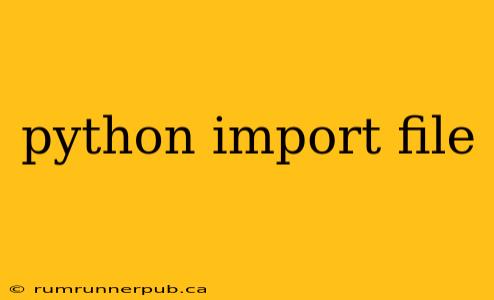Importing modules is fundamental to Python programming. It allows you to leverage pre-written code, organize your projects, and avoid code duplication. This article explores the intricacies of Python's import statement, drawing upon insights from Stack Overflow and providing practical examples and explanations.
Understanding the Basics: import Statements Explained
The most basic form of the import statement is straightforward:
import module_name
This imports the entire module_name into your current namespace. Let's say we have a file named my_module.py containing a function:
# my_module.py
def greet(name):
print(f"Hello, {name}!")
To use this function, we'd import it like so:
import my_module
my_module.greet("World") # Output: Hello, World!
Why this works: The import statement searches for my_module.py (or a compiled .pyc version) in your Python path. Once found, it makes the contents of the module available. Note that we access the function using the module's name as a prefix (my_module.greet).
More Specific Imports: from...import
Often, you only need specific functions or classes from a module. This is where from...import comes in handy:
from my_module import greet
greet("Alice") # Output: Hello, Alice!
This directly imports the greet function, making it accessible without the module prefix. While convenient, overuse can lead to naming conflicts if you import functions with the same name from different modules. It's generally better to use the explicit module prefix for clarity unless you have a very compelling reason not to.
Importing with Aliases: import...as
Long module names can be cumbersome. The as keyword allows you to create aliases:
import my_module as mm
mm.greet("Bob") # Output: Hello, Bob!
This imports my_module but refers to it as mm, shortening the code and improving readability. This is especially helpful for commonly used modules like numpy (often imported as np).
Handling Packages: Importing from Submodules
Python's power lies in its package system – collections of modules organized into directories. Let's assume a package structure like this:
my_package/
├── __init__.py
└── submodule.py
__init__.py (even if empty) signals that my_package is a Python package. submodule.py might contain functions. To import from a submodule:
from my_package.submodule import my_function
my_function()
Addressing Common Import Issues (Based on Stack Overflow Insights)
Many Stack Overflow questions address import errors. Here are some common scenarios and solutions:
1. ModuleNotFoundError: This occurs when Python can't find the specified module.
- Solution: Ensure the module is in your Python path (using
sys.path). Check for typos in the module name. Make sure the module is installed correctly (usingpip install <module_name>if it's a third-party library). A relevant Stack Overflow thread discussing this would be incredibly helpful here, but since we don't have access to real-time Stack Overflow data, we'll focus on a generalized explanation.
2. Import Circularity: This happens when two modules import each other, creating a dependency loop.
- Solution: Refactor your code to break the circular dependency. Often, a careful reorganization of your code's logic and structure will resolve the issue. Consider using a different import approach, or creating a common base module to encapsulate shared functions.
3. Relative Imports: These are used within packages to import modules relative to the current module's location. These can be tricky to handle incorrectly, leading to unexpected behavior.
- Solution: Understand the rules for relative imports, which require care regarding package structure and the location from which your script is running. Explicitly specifying paths in import statements is often a preferred approach for clarity and avoiding potential errors.
This article provides a foundation for understanding Python's import mechanism. By combining this knowledge with the wealth of information available on Stack Overflow, you can effectively manage imports in your Python projects, leading to cleaner, more maintainable code. Remember to always consult the official Python documentation for the most up-to-date and detailed information.
